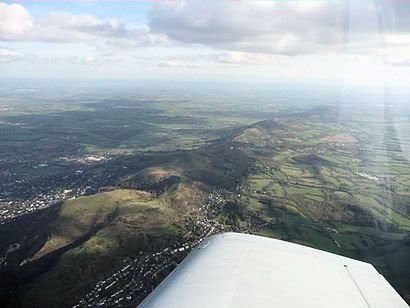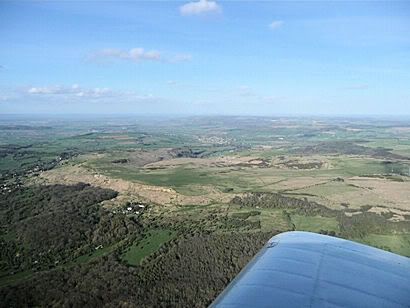With this in mind I booked a Wednesday evening for a relaxing ‘local’. I hoped to get away early, but of course no such luck. It wasn’t too bad though, I was at the airfield just before 17:00. I wandered out to the plane just in time to see another group member finishing up moving the plane back in the hangar – to be fair, he had waited with the plane out on the ramp until well past my booking start time of 16:15 and had assumed that I was a ‘no show’.
As luck would have it, it was our group member who is also an aircraft engineer and had recently installed our new Mode S transponder (this is now mandatory for all VFR flights in many European countries). He ran through how it all worked, which saved me a fair bit of reading up.
[RANT MODE ON] Just how pointless are Mode S transponders for VFR flights? Suffice to say that now there is a large area of the Netherlands that has imposed a ban on the use of Mode S transponders for VFR flights as far from ‘improving safety’ (as we were of course told by the bureaucrats) it produces so much ‘clutter’ that the controllers now cannot see ‘the wood for the trees’. Apparently, many pilots and controllers told the authorities that this is precisely what would happen, but were told that they were wrong etc.! So now some £2000 poorer, our group have been forced to buy a bit of kit that frankly will do nothing for us, in fact it will probably end up being a step backwards! Only governments and civil servants can do this! [RANT MODE OFF]
The plane had sufficient fuel and had already had a thorough check for the day, so I gave it a quick once over (walk around for obvious damage, physically check the fuel and oil levels), booked out and hopped in.
There had been a fair bit of wind during the day, and it was still a breeze at about 220/13kts at ground level. Nothing for a nosewheel aircraft, but worth knowing about for a tailwheel, particularly as regards likely runways and crosswinds. Fortunately, Gloucester have a runway 22, so no real crosswind, maybe even a nice headwind to flatter my landings with an agreeably short ground roll! Also, as the evening draws in, the winds tend to settle a bit anyway.
So I was soon rolling and airborne from 22. I was by myself tonight with a relatively light fuel load. So I was rewarded with amazing aircraft performance and 2000 fpm climb rates – wooo hoooo!

I bumbled out to the north west and paid my respects to the Malverns. I was up around 5000’ with very scattered and thin cumulus at about the same level. The visibility was great and the land below looked like a crisp and sharp aerial photo. It wasn’t too bumpy, just a few around the Malverns, so I tightened my shoulder straps so I wouldn’t smack my head against the canopy (not a good idea when you are flying solo).
It was quiet and peaceful, with only a handful of planes on the Gloucester Approach frequency. As usual, I bumbled over to Winchcombe, but this time descended to 2000’, the flew along in front of Cleeve Hill and the ridge of the Cotswolds just for the sheer joy of it.

A mandatory orbit or two of my home village, then back to Bredon Hill to get the ATIS and call for a rejoin.
Just heading back to Gloucester, I spotted a high wing jet some 2000 feet above me (where I had just been before I descended). It was either and HS125 or a C17 going into Fairford or Brize.
Given 22 right hand with a standard overhead join. I reported as usual at 2 miles and was told to switch to the tower frequency. I called the tower and unexpectedly got a ‘pass your message’ – I responded hesitantly that I was now closer than 2 miles and joining overhead for 22. He asked if I had been passed across from the Approach frequency as the penny dropped at his end. I confirmed and got the usual report downwind. Bit of a comms failure in the tower there methinks – to be fair, I have never personally heard this happen before at Gloucester, so I guess they were distracted.
As I flew crosswind, I spotted a Cessna outside and ahead of me at the same height. I wasn’t sure if he was going to depart the circuit or turn downwind. I was just about to turn downwind, when I saw him turning in a downwind direction, albeit further out. So I assumed he WAS in the circuit. Knowing that it was probably one of the local flying school Cessnas, rather than ‘have a race’ on the downwind leg and maybe unsettle the other pilot, I asked for an orbit for spacing (now aren’t I nice?). I did this and got suitably behind him and continued the circuit.
The wind had calmed a bit, but was about 230/09kts as I lined up on final for 22. I reminded myself that I was a lot lighter than normal, so drop the approach speed a bit and get ready for more float than normal.
I managed most of this and landed with a small ’spitfire hop’ (that’s my excuse anyway).
Then the final hurdle. I pulled up at the hangar with the hangar next door locked (so I couldn’t borrow their towbar) and our hangar with the jets parked up and no one else around. So I had to man-handle the tailwheel RV6 into a tight hangar space, single handed without a tow bar. In the event, I managed it pretty well – whether by luck or judgement I am not sure!
A great flight on a very pleasant evening. Well, another 0.9 hours logged and now up to nearly 450 hours total time. A nice bit of ‘quality time’ all by myself. I’ll do more of these, offering places to people at work that expressed an interest in going up with me.
